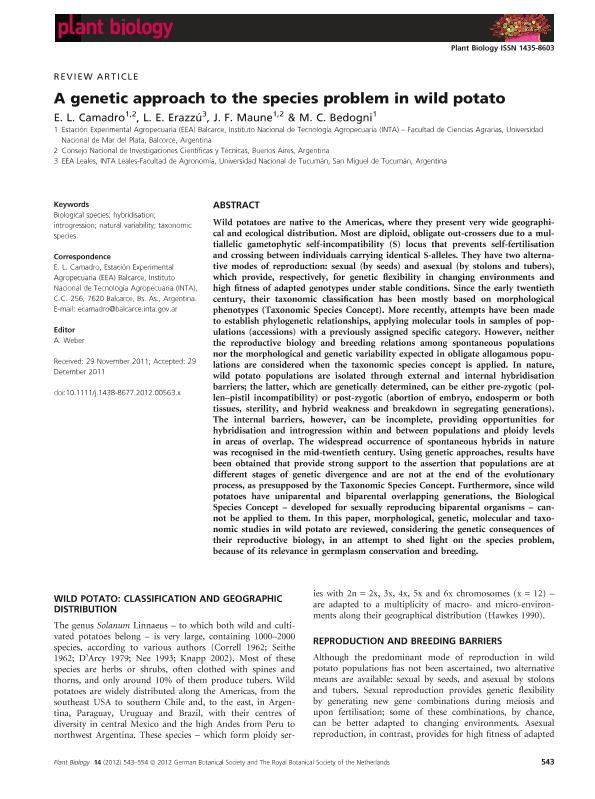Artículo
A genetic approach to the species problem in wild potato
Fecha de publicación:
07/2012
Editorial:
Wiley Blackwell Publishing, Inc
Revista:
Plant Biology
ISSN:
1435-8603
Idioma:
Inglés
Tipo de recurso:
Artículo publicado
Clasificación temática:
Resumen
Wild potatoes are native to the Americas, where they present very wide geographical and ecological distribution. Most are diploid, obligate out-crossers due to a multiallelic gametophytic self-incompatibility (S) locus that prevents self-fertilisation and crossing between individuals carrying identical S-alleles. They have two alternative modes of reproduction: sexual (by seeds) and asexual (by stolons and tubers), which provide, respectively, for genetic flexibility in changing environments and high fitness of adapted genotypes under stable conditions. Since the early twentieth century, their taxonomic classification has been mostly based on morphological phenotypes (Taxonomic Species Concept). More recently, attempts have been made to establish phylogenetic relationships, applying molecular tools in samples of populations (accessions) with a previously assigned specific category. However, neither the reproductive biology and breeding relations among spontaneous populations nor the morphological and genetic variability expected in obligate allogamous populations are considered when the taxonomic species concept is applied. In nature, wild potato populations are isolated through external and internal hybridisation barriers; the latter, which are genetically determined, can be either pre-zygotic (pollen-pistil incompatibility) or post-zygotic (abortion of embryo, endosperm or both tissues, sterility, and hybrid weakness and breakdown in segregating generations). The internal barriers, however, can be incomplete, providing opportunities for hybridisation and introgression within and between populations and ploidy levels in areas of overlap. The widespread occurrence of spontaneous hybrids in nature was recognised in the mid-twentieth century. Using genetic approaches, results have been obtained that provide strong support to the assertion that populations are at different stages of genetic divergence and are not at the end of the evolutionary process, as presupposed by the Taxonomic Species Concept. Furthermore, since wild potatoes have uniparental and biparental overlapping generations, the Biological Species Concept - developed for sexually reproducing biparental organisms - cannot be applied to them. In this paper, morphological, genetic, molecular and taxonomic studies in wild potato are reviewed, considering the genetic consequences of their reproductive biology, in an attempt to shed light on the species problem, because of its relevance in germplasm conservation and breeding.
Archivos asociados
Licencia
Identificadores
Colecciones
Articulos(CCT - MAR DEL PLATA)
Articulos de CTRO.CIENTIFICO TECNOL.CONICET - MAR DEL PLATA
Articulos de CTRO.CIENTIFICO TECNOL.CONICET - MAR DEL PLATA
Citación
Camadro, Elsa Lucila; Erazzú, Luis Ernesto; Maune, Juan Federico; Bedogni, María Cecilia; A genetic approach to the species problem in wild potato; Wiley Blackwell Publishing, Inc; Plant Biology; 14; 4; 7-2012; 543-554
Compartir
Altmétricas




